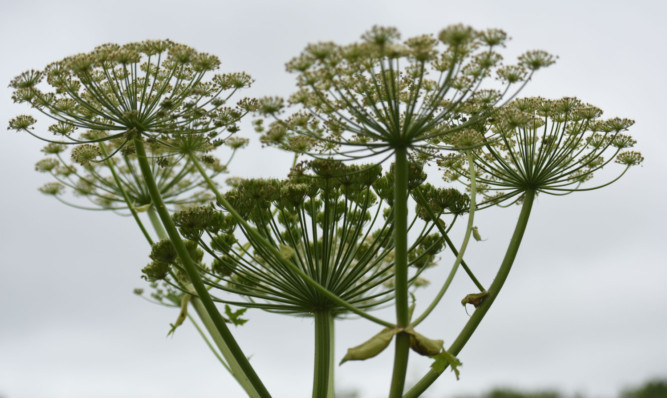An MSP has called for a Government campaign to teach the public about a toxic plant that is plaguing Courier Country.
Giant hogweed has been using the region as a breeding ground and infesting watercourses, railway embankments, waste ground and open green spaces.
The summer months are high season for the menace, which can cause huge blisters and burns on human skin, as well as possible blindness.
Earlier this month The Courier reported how the Carse of Gowrie and some residential parts of Perth have been badly affected, while the plant remains an issue for communities across Tayside, Angus and Fife.
Conservative MSP Murdo Fraser called on the Scottish Government to launch a widespread awareness campaign to teach the public about what the plant looks like, how to destroy it and how to deal with being exposed to it.
He said: “The dangers of touching or brushing up against the plant are far-ranging and can cause damage that is noticeable for years.”
Scottish Natural Heritage’s invasive non-native species expert, Stan Whitaker, backed calls for people to be educated on the dangers of the plant.
He said: “People should be made aware of what giant hogweed is and know not to mess with it. It can cause severe blistering to the skin which can last for many years after contact.”
A Dundee City Council spokesman said environmental management staff have been spraying giant hogweed since April, with warning signs installed in some problem locations.
An Angus council spokesman said: “We have undertaken additional hogweed control at the Dighty Burn up to the boundary of Angus and Dundee area this year, as well as dealing with small outbreaks elsewhere in Angus.”
It added: “The council co-operates and communicates with other organisations in Tayside that are also dealing with outbreaks in their areas, including Dundee City Council.”
Fife Council said they were not aware of any problems with giant hogweed on their property and the majority is found on private land, while Perth and Kinross Council stated they carry out treatment on various weeds when necessary.
What is giant hogweed and what can it do to you?
Giant hogweed, or heracleum mantegazzianum to give it its proper title, has been labelled as the “most dangerous plant in Britain” and for good reason.
Often mistaken for similar plants like common hogweed, cow parsley and elderflower, giant hogweed can grow to up to 13 feet high and has leaves up to five feet wide.
But although it looks harmless, sap from the plant’s reddish-purple stem has a poisonous effect on human skin and can cause other health problems.
Significant blistering which can take months to heal can occur within 48 hours of skin contact, and just a brush is enough to start a potential reaction.
Eye contact with the sap can also cause blindness, while complications with skin irritation can lead to Lime Disease (not to be confused with Lyme Disease) which makes skin hypersensitive to ultraviolet light.
How does the menace spread and how do you get rid of it?
A large weed which has white umbrella-shaped flower heads, giant hogweed was first brought to Britain from central Asia at the end of the 19th Century but is now widespread along river banks and canal
towpaths.
However, it can now also be found in a wide variety of public places like parks and cemeteries up and down the country.
The plant’s seeds are dispersed over short distances by wind but much longer distances by rivers and streams, hence their prevalence beside areas of water.
However, seeds which germinate easily and remain viable for up to 15 years can also be transported in soil on shoes or other contaminated objects.
Experts say that only specialists should try to tackle giant hogweed by spraying with herbicide or cutting plants down, but anyone trying to remove giant hogweed should wear long waterproof gloves, cover up skin and also wear eye protection.
